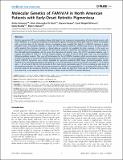| dc.contributor.author | Venturini, Giulia | en_US |
| dc.contributor.author | Di Gioia, Silvio Alessandro | en_US |
| dc.contributor.author | Harper, Shyana | en_US |
| dc.contributor.author | Weigel-DiFranco, Carol | en_US |
| dc.contributor.author | Rivolta, Carlo | en_US |
| dc.contributor.author | Berson, Eliot L. | en_US |
| dc.date.accessioned | 2014-04-11T14:12:40Z | |
| dc.date.issued | 2014 | en_US |
| dc.identifier.citation | Venturini, Giulia, Silvio Alessandro Di Gioia, Shyana Harper, Carol Weigel-DiFranco, Carlo Rivolta, and Eliot L. Berson. 2014. “Molecular Genetics of FAM161A in North American Patients with Early-Onset Retinitis Pigmentosa.” PLoS ONE 9 (3): e92479. doi:10.1371/journal.pone.0092479. http://dx.doi.org/10.1371/journal.pone.0092479. | en |
| dc.identifier.issn | 1932-6203 | en |
| dc.identifier.uri | http://nrs.harvard.edu/urn-3:HUL.InstRepos:12064487 | |
| dc.description.abstract | Retinitis pigmentosa (RP) is a hereditary disease that leads to the progressive degeneration of retinal photoreceptor cells and to blindness. It is caused by mutations in several distinct genes, including the ciliary gene FAM161A, which is associated with a recessive form of this disorder. Recent investigations have revealed that defects in FAM161A represent a rather prevalent cause of hereditary blindness in Israel and the Palestinian territories, whereas they seem to be rarely present within patients from Germany. Genetic or clinical data are currently not available for other countries. In this work, we screened a cohort of patients with recessive RP from North America to determine the frequency of FAM161A mutations in this ethnically-mixed population and to assess the phenotype of positive cases. Out of 273 unrelated patients, only 3 subjects had defects in FAM161A. A fourth positive patient, the sister of one of these index cases, was also identified following pedigree analysis. They were all homozygous for the p.T452Sfx3 mutation, which was previously reported as a founder DNA variant in the Israeli and Palestinian populations. Analysis of cultured lymphoblasts from patients revealed that mutant FAM161A transcripts were actively degraded by nonsense-mediated mRNA decay. Electroretinographic testing showed 30 Hz cone flicker responses in the range of 0.10 to 0.60 microvolts in all cases at their first visit (age 12 to 23) (lower norm = 50 μV) and of 0.06 to 0.32 microvolts at their most recent examination (age 27 to 43), revealing an early-onset of this progressive disease. Our data indicate that mutations in FAM161A are responsible for 1% of recessive RP cases in North America, similar to the prevalence detected in Germany and unlike the data from Israel and the Palestinian territories. We also show that, at the molecular level, the disease is likely caused by FAM161A protein deficiency. | en |
| dc.language.iso | en_US | en |
| dc.publisher | Public Library of Science | en |
| dc.relation.isversionof | doi:10.1371/journal.pone.0092479 | en |
| dc.relation.hasversion | http://www.ncbi.nlm.nih.gov/pmc/articles/PMC3961368/pdf/ | en |
| dash.license | LAA | en_US |
| dc.subject | Biology and Life Sciences | en |
| dc.subject | Genetics | en |
| dc.subject | Gene Identification and Analysis | en |
| dc.subject | Genetic Screens | en |
| dc.subject | Genetic Dominance | en |
| dc.subject | Autosomal Recessive Traits | en |
| dc.subject | Human Genetics | en |
| dc.subject | Medicine and Health Sciences | en |
| dc.subject | Ophthalmology | en |
| dc.subject | Retinal Disorders | en |
| dc.title | Molecular Genetics of FAM161A in North American Patients with Early-Onset Retinitis Pigmentosa | en |
| dc.type | Journal Article | en_US |
| dc.description.version | Version of Record | en |
| dc.relation.journal | PLoS ONE | en |
| dash.depositing.author | Berson, Eliot L. | en_US |
| dc.date.available | 2014-04-11T14:12:40Z | |
| dc.identifier.doi | 10.1371/journal.pone.0092479 | * |
| dash.contributor.affiliated | Berson, Eliot L. | |


